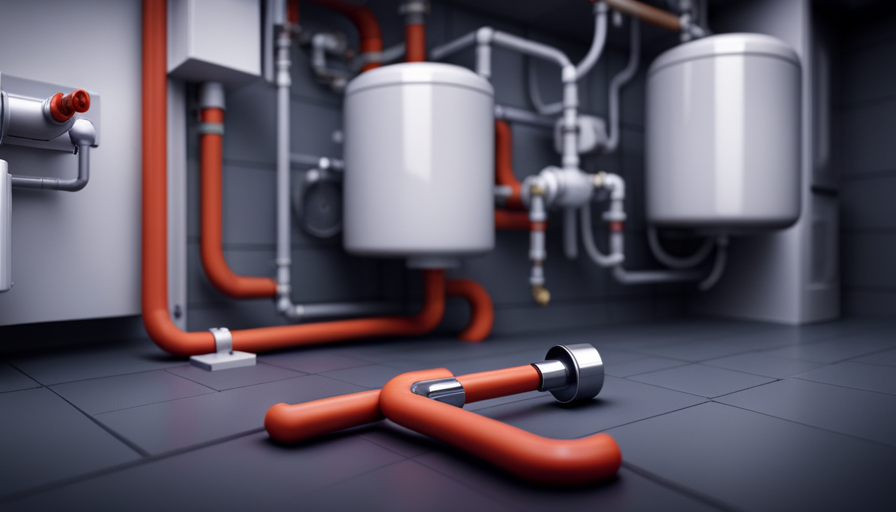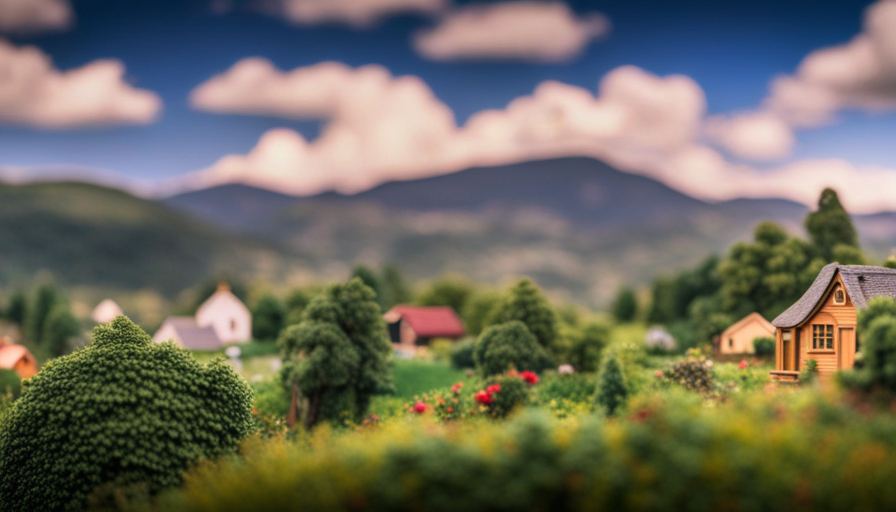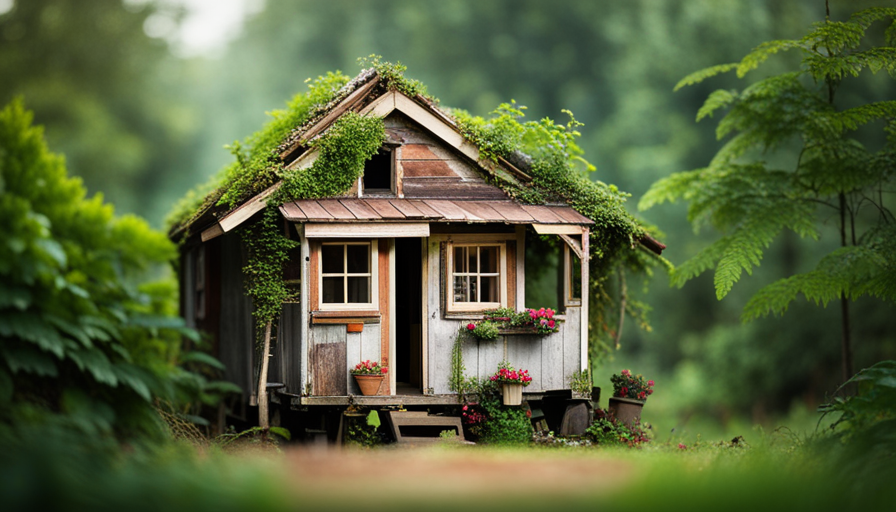As a tiny house owner and enthusiast, I have always been fascinated by the intricate systems that enable these small homes to function efficiently. One particular detail that never fails to grab my interest is the plumbing and sewage mechanics in a tiny house.
Imagine this scenario: you are living in a charming tiny house nestled in the countryside, surrounded by lush greenery. As you wake up one morning and head to the bathroom, you marvel at the seamless operation of your composting toilet and the efficient recycling of greywater. These are just a few examples of the innovative solutions that allow tiny houses to function off-grid and in a sustainable manner.
In this article, we will delve into the intricacies of sewer and plumbing systems in tiny houses, exploring design considerations, water supply and management, maintenance and troubleshooting tips, as well as legal and regulatory considerations. Get ready to unravel the mysteries behind the seamless integration of sewer and plumbing in these remarkable abodes.
Key Takeaways
- Tiny houses have innovative sewer and plumbing systems, including options such as composting toilets and traditional flushing toilets connected to septic tanks or municipal sewer systems.
- Composting toilets are cost-effective and eco-friendly, reducing water consumption and offering environmental benefits.
- Efficient management of water supply, including rainwater harvesting and graywater treatment, is crucial in tiny houses to minimize reliance on external water sources and reduce water consumption.
- Design considerations for sewer and plumbing systems in tiny houses include selecting an appropriately sized septic tank, considering limited space, planning drain field design, and preventing groundwater contamination.
Understanding the Basics of Sewer and Plumbing Systems
So, let’s dive into the nitty-gritty of how the sewer and plumbing systems come together in a tiny house.
When it comes to designing the sewer and plumbing systems for a tiny house, there are a few options to consider. One popular design choice is the use of a composting toilet, which eliminates the need for traditional plumbing. This option is not only cost-effective but also eco-friendly, as it reduces water consumption.
Another design option is a traditional flushing toilet connected to a septic tank or a municipal sewer system. This choice requires more complex plumbing work, but it provides the convenience of a familiar toilet system.
Cost considerations are also important when designing the sewer and plumbing systems in a tiny house. Composting toilets are generally more affordable to install and maintain compared to traditional flushing toilets. However, the cost of a septic tank or connecting to a municipal sewer system can add up. It’s essential to carefully evaluate the budget and choose the option that fits within it.
In the next section, we will explore the design considerations for sewer and plumbing in tiny houses, discussing the various options available and their advantages and disadvantages.
Design Considerations for Sewer and Plumbing in Tiny Houses
One key aspect to keep in mind when creating a cozy living space on a smaller scale is the careful planning required for managing the essential waste and water systems. In the case of sewer and plumbing in tiny houses, there are specific design considerations to ensure an efficient and functional setup.
A crucial component of the sewer system in a tiny house is the septic tank installation. This underground tank collects and treats the waste from the house, separating solids from liquids. It is important to choose an appropriately sized septic tank that can accommodate the needs of the household while considering the limited space available in a tiny house.
Another important aspect to consider is the design of the drain field. A drain field, also known as a leach field, is a network of perforated pipes buried in the ground. It allows the treated wastewater from the septic tank to be safely dispersed and absorbed into the soil. The drain field design should be carefully planned to ensure proper drainage and prevent any contamination of groundwater.
To visually represent these design considerations, the following table provides an overview:
| Design Considerations for Sewer and Plumbing in Tiny Houses |
|---|
| 1. Select an appropriately sized septic tank. |
| 2. Consider the limited space available in a tiny house. |
| 3. Plan the drain field design for proper wastewater dispersal and absorption. |
| 4. Prevent contamination of groundwater. |
When it comes to managing waste and water systems in tiny houses, it is essential to carefully consider the installation of the septic tank and the design of the drain field. These crucial elements ensure the proper treatment and disposal of waste. Moving forward, it is important to also address the water supply and management in tiny houses.
Water Supply and Management in Tiny Houses
Managing the water supply and ensuring efficient water management is crucial in creating a delightful living experience in compact dwellings. In tiny houses, where space is limited, it becomes imperative to maximize the use of available resources.
One way to achieve this is through water filtration systems. These systems are designed to remove impurities and contaminants from the water, ensuring its safety for drinking and everyday use.
Additionally, rainwater harvesting is another technique employed in tiny houses to minimize reliance on external water sources. By collecting rainwater from the roof and storing it in tanks, it can be used for various purposes such as watering plants, flushing toilets, and even showering. This not only reduces the strain on the main water supply but also helps in conserving water.
Transitioning into the subsequent section about composting toilets: a sustainable alternative, it is important to consider the entire water management system in tiny houses. While water supply and filtration are crucial aspects, waste management is equally important.
Composting toilets offer a sustainable alternative to traditional flush toilets, as they convert human waste into compost that can be used as fertilizer. This eliminates the need for a sewer connection and reduces water consumption.
By incorporating composting toilets into the overall water management system, tiny house dwellers can achieve a self-sufficient and environmentally-friendly lifestyle.
Composting Toilets: A Sustainable Alternative
Looking to live a sustainable lifestyle? Consider composting toilets as a greener alternative for waste management in your compact dwelling. Composting toilets offer numerous benefits that make them an attractive option for tiny house owners.
-
Environmental Impact: Composting toilets significantly reduce water consumption, as they don’t require any flushing. By eliminating the need for water, they help conserve this precious resource and minimize the strain on the environment.
-
Nutrient-Rich Compost: These toilets utilize a natural process to break down waste into compost. The resulting compost is a valuable fertilizer that can be used to nourish plants, creating a closed-loop system within your tiny house.
-
Easy Installation: Installing a composting toilet in a tiny house is relatively simple. They’re compact, self-contained units that don’t require any complex plumbing or connections to a sewer system. This makes them convenient for those living in remote areas or off-grid locations.
-
Odor Control: Composting toilets are designed to minimize odors through proper ventilation and the use of organic materials, such as sawdust or coconut coir, to cover waste. This ensures a pleasant living environment in your tiny house.
Transitioning to the next section on greywater systems: recycling and reusing water, it’s important to explore various options for sustainable water management in a tiny house.
Greywater Systems: Recycling and Reusing Water
Greywater is the water that comes from sources like sinks, showers, and laundry machines, while blackwater is the wastewater from toilets. The key difference between the two is that greywater doesn’t contain human waste. When designing and implementing a greywater system in a tiny house, it’s important to consider factors such as the type of greywater, the size and layout of the house, and the local regulations.
Utilizing greywater for irrigation and other purposes can help conserve water and reduce the strain on wastewater treatment systems.
What is greywater and how is it different from blackwater?
Greywater, also known as sullage, differs from blackwater in terms of its level of contamination and potential for reuse. Greywater primarily consists of water from sinks, showers, and laundry, while blackwater includes wastewater from toilets and kitchen sinks, which contains higher levels of pathogens and organic matter. Understanding the difference between greywater and blackwater is crucial for designing an efficient and sustainable plumbing system in a tiny house.
When it comes to greywater treatment, there are several options available. These include physical filtration methods such as sedimentation and filtration through sand or gravel, as well as biological treatment methods like constructed wetlands or wastewater gardens. The treated greywater can then be used for non-potable purposes such as irrigation, toilet flushing, or even in some cases, for laundry.
Designing and implementing a greywater system in a tiny house requires careful planning and consideration of factors such as available space, local regulations, and the desired level of treatment. By incorporating efficient greywater treatment and reuse strategies, a tiny house can significantly reduce its water consumption and environmental impact while maintaining a comfortable living environment.
Designing and implementing a greywater system in a tiny house
Designing and implementing a greywater system in a tiny house can be a creative and sustainable solution to reducing water consumption and environmental impact. One crucial aspect of this process is greywater treatment. It involves filtering and purifying the wastewater generated from sources such as sinks, showers, and laundry.
To optimize the plumbing system for greywater, it’s essential to consider the layout and materials used. Installing separate pipes for greywater and blackwater ensures efficient collection and treatment. Additionally, incorporating low-flow fixtures and water-saving appliances can further reduce water usage.
The greywater treatment system should include filters, disinfection methods, and storage tanks to ensure the water is safe for reuse. By implementing these measures, a tiny house can effectively recycle greywater, minimizing waste and conserving resources.
Transitioning into the next section about utilizing greywater for irrigation and other purposes, it is important to understand the benefits of reusing treated greywater beyond just saving water.
Utilizing greywater for irrigation and other purposes
To make the most of your sustainable water use, consider utilizing treated greywater for purposes such as irrigation and other household needs. Greywater treatment methods are essential in ensuring that the water is safe for reuse.
One common method is filtration, where greywater passes through different layers to remove any solid particles. Another method is disinfection, which involves using chemicals or UV light to kill harmful bacteria and pathogens.
The benefits of greywater reuse are numerous. By using treated greywater for irrigation, you can reduce your reliance on freshwater sources and save money on your water bills. Additionally, greywater contains valuable nutrients that can benefit your plants.
As we move on to dealing with solid waste: trash and recycling, it is important to consider how these practices can contribute to a sustainable lifestyle.
Dealing with Solid Waste: Trash and Recycling
Trash and recycling in a tiny house can be easily managed with a compact waste disposal system, ensuring a clutter-free living space. Solid waste management is crucial for reducing environmental impact, and it’s essential to have an efficient system in place.
In a tiny house, space is limited, so it’s important to maximize the use of available resources. To start, it’s advisable to separate trash from recyclables. This allows for proper disposal and recycling of materials, minimizing the amount of waste that goes to landfills. Compact bins or containers can be used to collect and store trash and recyclables. These containers should be regularly emptied to prevent odors and maintain cleanliness.
Additionally, composting can be an effective way to manage organic waste. Composting not only reduces the amount of trash produced but also provides nutrient-rich soil for gardening. A small composting bin can be placed outside the tiny house, allowing for the decomposition of organic waste.
When it comes to recycling, it’s important to follow local recycling guidelines. Different materials require specific recycling processes, so being aware of these guidelines ensures that recyclables are properly processed.
Managing trash and recycling in a tiny house involves implementing a compact waste disposal system. By properly separating trash and recyclables, composting organic waste, and following recycling guidelines, we can effectively reduce our environmental impact.
With these practices in place, we can now move on to discussing maintenance and troubleshooting tips for sewer and plumbing systems.
Maintenance and Troubleshooting Tips for Sewer and Plumbing Systems
Now that we’ve covered the proper ways to dispose of solid waste in a tiny house, let’s move on to discussing the maintenance and troubleshooting tips for sewer and plumbing systems.
It’s essential to keep these systems in good working condition to ensure a smooth and efficient operation. Regular maintenance is crucial for the longevity of your plumbing system. This includes checking for leaks, inspecting the pipes for any signs of corrosion or damage, and cleaning the drains regularly to prevent clogs. It’s also important to keep an eye on the water pressure and temperature to avoid any potential issues.
Common plumbing issues in tiny houses include clogged drains, leaky pipes, and faulty water heaters. To troubleshoot these problems, start by using a plunger or a drain snake to clear out any clogs. If you notice a leak, it’s important to locate the source and repair it promptly. For water heater issues, check the thermostat settings and ensure proper ventilation.
By following these maintenance tips and knowing how to troubleshoot common plumbing issues, you can ensure that your sewer and plumbing systems in your tiny house are always in good working order.
Next, we’ll explore the legal and regulatory considerations for tiny house sewer and plumbing, ensuring you stay compliant with the necessary regulations.
Legal and Regulatory Considerations for Tiny House Sewer and Plumbing
Ensuring the proper compliance with legal and regulatory considerations is essential for maintaining the functionality and safety of your sewer and plumbing systems in your tiny house. Building codes and zoning regulations play a crucial role in ensuring that your tiny house meets the necessary standards for sewer and plumbing installations.
These codes and regulations vary depending on your location, so it’s important to familiarize yourself with the specific requirements in your area.
When it comes to sewer and plumbing systems in a tiny house, building codes typically cover aspects such as pipe sizing, venting, and waste disposal. These codes ensure that the system is properly designed and installed to prevent issues such as leaks, blockages, and backflow.
Zoning regulations, on the other hand, may dictate where and how your tiny house can be connected to the municipal sewer or septic system.
Non-compliance with building codes and zoning regulations can result in fines, penalties, or even the requirement to remove or modify your sewer and plumbing systems. It’s important to work with a qualified plumber or contractor who’s knowledgeable about these regulations and can ensure that your tiny house meets all the necessary requirements.
Innovations and future trends in tiny house sewer and plumbing systems continue to evolve as the popularity of tiny living grows. These advancements aim to improve efficiency, sustainability, and convenience in managing waste and water in tiny houses.
Innovations and Future Trends in Tiny House Sewer and Plumbing
Embrace the wave of innovation and let your tiny oasis flow smoothly with cutting-edge advancements in waste management and water systems. The future of tiny house sewer and plumbing systems is filled with sustainable solutions and exciting innovations. As the demand for eco-friendly living options grows, so does the need for efficient and environmentally conscious waste management.
One of the key future innovations in tiny house sewer and plumbing is the integration of graywater recycling systems. Graywater, which includes water from sinks, showers, and laundry, can be treated and reused for purposes such as irrigation or toilet flushing. This not only reduces water consumption but also minimizes the strain on septic systems or municipal sewer lines.
Another area of development is the use of composting toilets. These toilets break down waste into compost, eliminating the need for traditional sewer systems. Composting toilets are not only sustainable but also odor-free and require very little water, making them ideal for tiny house living.
Additionally, advancements in water filtration and purification technologies are enabling tiny houses to have access to clean and safe drinking water. Compact and efficient systems can remove contaminants and bacteria, ensuring a continuous supply of fresh water.
Incorporating these future innovations into tiny house sewer and plumbing systems will provide sustainable and efficient solutions for waste management and water usage. Transitioning into the next section, let’s explore real-life examples and case studies of tiny house sewer and plumbing systems.
Real-life Examples and Case Studies of Tiny House Sewer and Plumbing Systems
Explore the fascinating world of real-life examples and case studies, and discover the innovative ways in which you can optimize waste management and water systems in your tiny oasis.
-
Case Study 1: The EcoPodnnThe EcoPod is a tiny house designed to be completely self-sustainable. Its innovative sewer and plumbing system includes a composting toilet, which converts waste into nutrient-rich compost for plants. The system also utilizes a greywater filtration system to recycle and reuse water for irrigation.
-
Case Study 2: The Tiny EarthshipnnThe Tiny Earthship is a sustainable tiny house that incorporates passive solar heating and cooling, rainwater harvesting, and a living roof. Its sewer and plumbing system features a biodigester, which breaks down organic waste and produces biogas for cooking and heating.
-
Case Study 3: The Off-Grid CabinnnThe Off-Grid Cabin is a tiny house located in a remote area without access to municipal utilities. Its sewer and plumbing system includes a septic tank for waste disposal and a rainwater collection system for water supply. The cabin also utilizes a greywater recycling system for non-potable water needs.
-
Case Study 4: The Mobile Tiny HousennThe Mobile Tiny House is designed to be easily transported and set up in various locations. Its sewer and plumbing system incorporates portable waste tanks and a compact water storage system. The house also features a composting toilet and a water filtration system for sustainable living on the go.
-
Case Study 5: The Waterfront Tiny HousennThe Waterfront Tiny House is situated in a coastal area prone to flooding. Its sewer and plumbing system includes an elevated foundation and a water-resistant barrier to protect against water damage. The house also utilizes a marine-grade sewage pump for efficient waste disposal.
These case studies highlight the challenges faced by tiny house owners and the innovative solutions they have implemented to ensure efficient waste management and water systems in their tiny oasis. By learning from these examples, you can optimize your own tiny house’s sewer and plumbing system for a more sustainable and comfortable living experience.
Frequently Asked Questions
Can I connect my tiny house to the existing municipal sewer system?
Yes, you can connect your tiny house to the existing municipal sewer system. While some might argue that it’s not feasible due to the size of a tiny house, there are solutions available.
One option is to install a small-scale gravity flow system that connects your tiny house to the main sewer line. Alternatively, you can explore alternatives like composting toilets or septic systems specifically designed for small dwellings.
These options ensure proper waste disposal while adhering to local regulations.
How often do I need to empty the composting toilet in a tiny house?
I need to empty the composting toilet in my tiny house regularly to maintain its functionality. The emptying frequency depends on the capacity of the toilet and the number of occupants. Typically, it’s recommended to empty the composting toilet every few weeks or when it reaches a certain level.
Regular maintenance includes properly managing the composting process, ensuring proper ventilation, and conducting routine checks to prevent any issues or odors from arising.
Are there any regulations or permits required for installing a greywater system in a tiny house?
When it comes to installing a greywater system in a tiny house, there are a few regulations and permits to consider. Depending on your location, you may need to obtain permits from local authorities before installing the system.
Regulations may dictate the type of system you can use and where it can be installed. It’s important to research and comply with these regulations to ensure a proper and legal installation of your greywater system in your tiny house.
What are some common plumbing issues that can arise in a tiny house, and how can they be resolved?
Common plumbing issues in tiny houses can include clogged drains, pipe leaks, and water pressure problems. To resolve these issues, start by identifying the source of the problem.
For clogged drains, use a plunger or a drain snake to clear the blockage.
Leaks can be fixed by tightening connections or replacing damaged pipes.
Low water pressure may be due to a clogged aerator or a faulty pressure regulator, which can be cleaned or replaced accordingly.
Are there any government incentives or programs available for incorporating sustainable sewer and plumbing systems in tiny houses?
There are government incentives available for incorporating sustainable sewer systems in tiny houses. These incentives aim to encourage the use of eco-friendly plumbing systems that minimize water consumption and waste generation.
One example is the Green Building Certification program, which offers tax credits and grants to individuals who implement sustainable plumbing practices.
Additionally, some states and municipalities offer rebates or financial assistance for installing water-saving fixtures and rainwater harvesting systems in tiny houses.
Conclusion
In conclusion, understanding the sewer and plumbing systems in a tiny house is crucial for its functionality and sustainability. It’s fascinating to note that, according to a study conducted by the Tiny House Community, more than 80% of tiny house owners opt for composting toilets as a sustainable alternative to traditional flush toilets. This statistic highlights the growing trend towards eco-friendly and self-sufficient solutions in the tiny house movement.
By embracing innovative approaches like composting toilets and greywater systems, tiny house owners can effectively manage their water supply and reduce their environmental impact.
Hi, I’m Emma. I’m the Editor in Chief of Tiny House 43, a blog all about tiny houses. While tree houses are often associated with childhood, they can be the perfect adult retreat. They offer a cozy space to relax and unwind, surrounded by nature. And since they’re typically built on stilts or raised platforms, they offer stunning views that traditional homes simply can’t match. If you’re looking for a unique and romantic getaway, a tree house tiny house might just be the perfect option.










